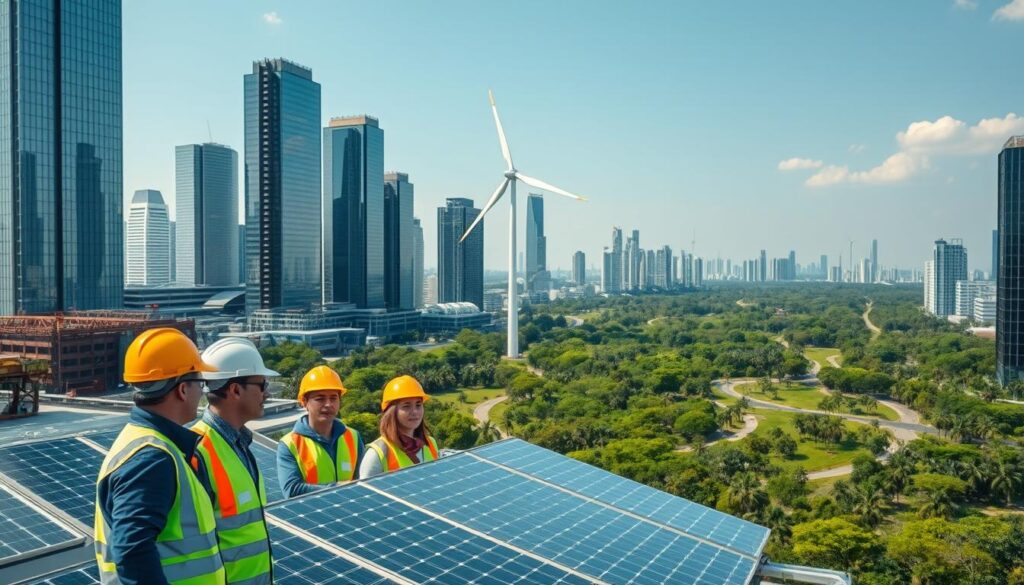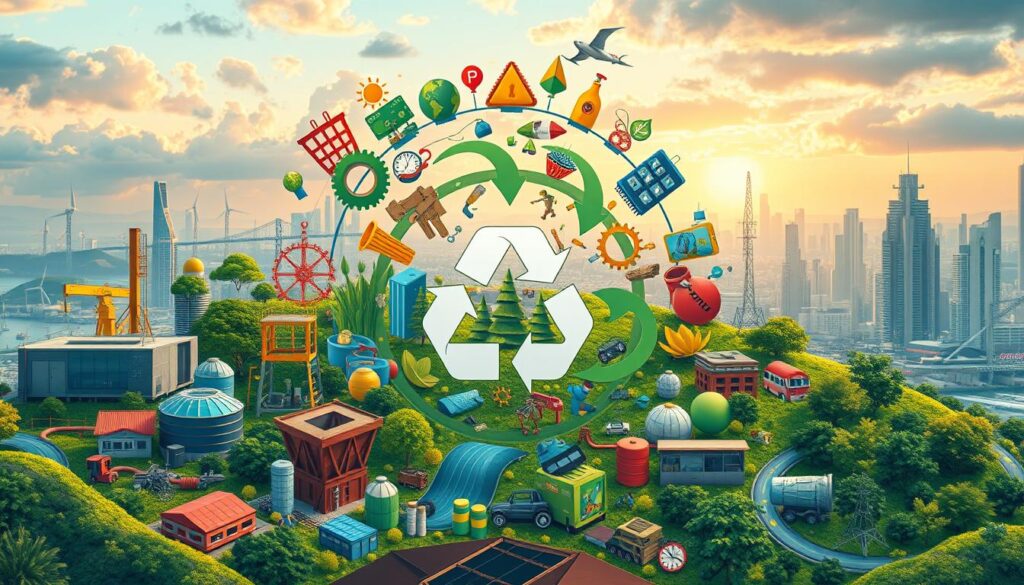The world is witnessing a significant shift towards eco-friendly technology and green design practices, revolutionizing infrastructure development, energy production, and resource management.
By adopting renewable energy solutions, we can mitigate climate change and create a more sustainable future. Sustainable engineering is at the forefront of this transformation, integrating innovative practices to reduce environmental impact.
This article explores the principles and innovations driving this change, highlighting the importance of environmentally conscious practices in shaping a greener tomorrow.
Key Takeaways
- Eco-friendly technologies are transforming infrastructure development.
- Green design practices are crucial for reducing environmental impact.
- Renewable energy solutions are key to mitigating climate change.
- Sustainable engineering is driving innovation in resource management.
- Environmentally conscious practices are essential for a greener future.
The Fundamentals of Sustainable Engineering
The principles of sustainable engineering are crucial for creating a greener future. Sustainable engineering is an approach that aims to minimize the environmental impact of infrastructure development while promoting social equity and economic viability.
Defining Sustainable Engineering Principles
Sustainable engineering principles are centered around the idea of reducing the environmental footprint of human activities. This involves adopting innovative technologies and design strategies that minimize waste, reduce energy consumption, and promote the use of renewable resources. Eco-friendly materials and energy-efficient systems are key components of sustainable engineering.
| Principle | Description | Benefit |
|---|---|---|
| Minimize Waste | Reduce, Reuse, Recycle | Conserves Resources |
| Energy Efficiency | Optimize Energy Use | Reduces Emissions |
| Renewable Resources | Utilize Solar, Wind, Hydro | Sustainable Energy |
The Triple Bottom Line Approach
The triple bottom line approach is a framework that guides decision-making in sustainable engineering projects. It considers three key factors: economic, social, and environmental. By balancing these factors, engineers can develop infrastructure that is not only environmentally friendly but also socially responsible and economically viable.
This approach encourages the use of sustainable materials and responsible sourcing practices, ultimately contributing to a more sustainable future.
The Evolution of Green Engineering Practices
The evolution of green engineering is a story of continuous improvement, shaped by historical milestones and modern sustainability standards. Green engineering practices have come a long way, driven by advances in technology and changing environmental policies.

Historical Development and Milestones
The historical development of green engineering practices is marked by several key milestones. Early initiatives focused on energy-efficient systems, which significantly reduced the environmental impact of buildings and industrial processes. The 1970s energy crisis, for instance, spurred innovation in energy-efficient technologies. Energy-efficient design became a cornerstone of green engineering, with buildings being designed to maximize natural light and minimize energy consumption.
Another significant milestone was the development of green building standards and certification programs. The establishment of LEED (Leadership in Energy and Environmental Design) in the late 1990s provided a framework for evaluating the environmental performance of buildings. This certification program has since become a global standard, promoting best practices in green building.
Modern Frameworks and Standards
Today, modern frameworks and standards play a crucial role in guiding green engineering practices. These frameworks ensure that green engineering projects are not only environmentally sustainable but also economically viable. The International Green Construction Code (IgCC) is one such standard that sets requirements for building design, construction, and operation to reduce environmental impacts.
Furthermore, the integration of green building technologies such as solar panels, wind turbines, and green roofs has become more prevalent. These technologies, coupled with advanced building management systems, optimize energy use and reduce carbon footprints. The continuous development of these technologies and standards underscores the dynamic nature of green engineering practices.
Environmental Impact Assessment Methodologies
Environmental impact assessment methodologies play a vital role in shaping sustainable practices. By evaluating the potential environmental consequences of engineering projects, these methodologies help identify areas for improvement and inform strategies for reducing environmental footprint.
Life Cycle Assessment Techniques
Life cycle assessment (LCA) is a comprehensive method used to evaluate the environmental impacts of a product or system throughout its entire life cycle, from raw material extraction to end-of-life disposal or recycling. LCA involves several stages, including goal and scope definition, inventory analysis, impact assessment, and interpretation. By considering all stages of a product’s life cycle, LCA provides a holistic understanding of environmental impacts and helps engineers make informed decisions.
For instance, LCA can be applied to compare the environmental impacts of different materials used in construction projects. This allows engineers to select materials that minimize environmental harm while meeting project requirements.
Carbon Footprint Calculation and Reduction
Carbon footprint calculation is another critical methodology used to assess the environmental impact of engineering projects. It involves quantifying the amount of greenhouse gas emissions associated with a particular product, process, or organization. By identifying areas with high carbon emissions, engineers can develop targeted strategies for reduction.
Effective carbon footprint reduction strategies include improving energy efficiency, switching to renewable energy sources, and optimizing supply chain operations. By implementing these strategies, engineers can significantly reduce the carbon footprint of their projects and contribute to a more sustainable future.
Sustainable Materials and Resources
In the pursuit of sustainability, the choice of materials is a critical factor in green engineering. The selection of sustainable materials plays a vital role in reducing the environmental footprint of construction projects and infrastructure development.
Eco-Friendly Building Materials
Eco-friendly building materials are essential for minimizing environmental impact. These materials are designed to be sustainable throughout their lifecycle, from sourcing to disposal.
Recycled and Upcycled Materials
Recycled and upcycled materials are gaining popularity in construction. These materials reduce waste and conserve natural resources. Examples include recycled steel, reclaimed wood, and upcycled glass.
Biodegradable Alternatives
Biodegradable alternatives offer a sustainable solution to traditional building materials. These materials can decompose naturally, reducing landfill waste and environmental harm. Examples include biodegradable insulation and bioplastics.

Responsible Sourcing Practices
Responsible sourcing practices ensure that materials are extracted, processed, and transported in a manner that minimizes environmental harm and promotes social responsibility. This includes sourcing materials from certified sustainable forests and using suppliers who adhere to environmental standards.
| Material | Sustainable Sourcing Practice | Environmental Benefit |
|---|---|---|
| Timber | FSC Certification | Conservation of forests |
| Steel | Recycling | Reduction in energy consumption |
| Concrete | Use of supplementary cementitious materials | Lower carbon footprint |
Material Efficiency Strategies
Material efficiency strategies aim to minimize waste and optimize the use of materials. Techniques include designing for deconstruction, using prefabricated components, and implementing just-in-time delivery to reduce on-site waste.
“The most sustainable material is the one that is not used.” –
By adopting sustainable materials and resources, engineers can significantly reduce the environmental impact of construction projects. This not only contributes to a greener future but also enhances the sustainability of infrastructure development.
Green Building Technologies and Design
As the world shifts towards sustainability, green building technologies are playing a pivotal role in this transformation. Green building technologies encompass a broad spectrum of innovative solutions aimed at reducing the environmental footprint of buildings.
Energy-Efficient Building Systems
Energy-efficient building systems are crucial for minimizing energy consumption. These systems include advanced technologies such as LED lighting, high-performance HVAC systems, and smart building technologies that optimize energy use.
- LED lighting reduces energy consumption significantly compared to traditional lighting methods.
- High-performance HVAC systems ensure optimal heating and cooling while minimizing energy waste.
- Smart building technologies integrate various systems to optimize energy efficiency.
Passive Design Strategies
Passive design strategies are fundamental to green building. These strategies involve designing buildings that work with the natural environment to reduce the need for mechanical heating and cooling.
Key passive design strategies include:
- Optimizing building orientation to maximize natural light and heat.
- Using thermal mass to absorb and release heat.
- Incorporating natural ventilation techniques to reduce the need for air conditioning.
Green Building Certification Programs
Green building certification programs recognize and promote best practices in green building. These programs provide a framework for assessing the environmental performance of buildings.
Some prominent green building certification programs include:
- LEED (Leadership in Energy and Environmental Design)
- Green Globes
- Passive House
Renewable Energy Solutions in Engineering
The integration of renewable energy solutions in engineering is crucial for reducing our reliance on fossil fuels and mitigating climate change. As engineers, adopting renewable energy sources is not just a trend but a necessity for creating a sustainable future.

Solar Engineering Applications
Solar engineering involves the design and implementation of solar energy systems, including photovoltaic panels and solar thermal systems. These technologies harness the power of the sun to generate electricity or heat, providing a clean alternative to fossil fuels. Solar energy is particularly effective in regions with high solar irradiance, making it a viable option for powering homes, businesses, and industrial processes.
Wind Energy Systems
Wind energy systems convert the kinetic energy of wind into electricity using wind turbines. This form of renewable energy is becoming increasingly popular due to its scalability and the decreasing cost of technology. Wind farms, both onshore and offshore, are being developed worldwide to harness this clean energy source. Wind energy not only reduces greenhouse gas emissions but also creates jobs and stimulates local economies.
Emerging Renewable Technologies
Beyond solar and wind, other renewable energy technologies are emerging as significant players in the sustainable energy landscape. These include tidal and wave energy, as well as geothermal systems, which offer promising alternatives for power generation.
Tidal and Wave Energy
Tidal and wave energy technologies capture the energy from ocean tides and waves, providing a predictable and reliable source of renewable energy. These technologies are still in the early stages of development but hold great potential for coastal regions. Tidal barrages and wave energy converters are examples of devices being developed to harness this energy.
Geothermal Systems
Geothermal systems utilize the heat from the Earth’s core to generate electricity or provide heating and cooling. This renewable energy source is particularly suitable for regions with significant volcanic activity. Geothermal power plants can operate continuously, providing a stable source of energy. Additionally, geothermal heat pumps can be used for efficient heating and cooling of buildings.
In conclusion, renewable energy solutions are transforming the engineering landscape by providing cleaner, more sustainable alternatives to traditional energy sources. As technology continues to evolve, the integration of solar, wind, and emerging renewable technologies will play a crucial role in shaping a greener future.
Sustainable Water Management and Conservation
Sustainable water management practices are essential for ensuring a greener future. As the global population continues to grow, the demand for water increases, making conservation and efficient use of this resource critical. Effective water management not only helps in conserving water but also in protecting ecosystems and ensuring the long-term sustainability of our planet’s water resources.
Water-Efficient Technologies
Water-efficient technologies play a crucial role in reducing water consumption. These include low-flow fixtures and greywater reuse systems that minimize water waste. Advanced irrigation systems that use precision agriculture techniques also significantly reduce water usage in agriculture. By adopting these technologies, communities can significantly lower their water footprint.
Innovative Wastewater Treatment Systems
Innovative wastewater treatment systems are vital for improving water quality and reducing the environmental impact of wastewater. Technologies such as membrane bioreactors and advanced oxidation processes offer efficient and effective ways to treat wastewater, making it possible to reuse water for various purposes. These systems not only help in conserving water but also in protecting water bodies from pollution.
By implementing these innovative wastewater treatment systems, communities can ensure a sustainable water cycle that supports both human needs and environmental health.
Climate-Resilient Infrastructure Development
As the world grapples with the escalating impacts of climate change, the need for climate-resilient infrastructure has become more pressing than ever. Developing infrastructure that can withstand the challenges posed by climate change is crucial for safeguarding communities and ensuring sustainable development.

Designing for Climate Change Adaptation
Designing infrastructure with climate change adaptation in mind involves understanding projected climate changes and developing structures that can accommodate these changes. This includes considering factors such as rising sea levels, increased precipitation, and more frequent extreme weather events. By incorporating climate resilience into infrastructure design, we can reduce the risk of damage and promote sustainability.
Key strategies for climate change adaptation include:
- Using sea walls and levees to protect against rising sea levels
- Implementing green infrastructure to manage stormwater runoff
- Designing buildings with adaptable and resilient materials
According to the
“The adaptation of infrastructure to the impacts of climate change is not just a technical challenge, but also a social and economic one.”
Disaster-Resistant Engineering Solutions
Disaster-resistant engineering solutions play a critical role in developing climate-resilient infrastructure. By applying advanced engineering techniques and materials, we can enhance the resilience of infrastructure to natural disasters. This includes designing structures that can withstand high winds, earthquakes, and floods.
| Disaster Type | Engineering Solution | Benefits |
|---|---|---|
| Floods | Elevated structures and flood-resistant materials | Reduces damage to infrastructure and property |
| Earthquakes | Seismic design and retrofitting | Enhances structural integrity and safety |
| High Winds | Wind-resistant design and materials | Minimizes damage and loss |
By integrating disaster-resistant engineering solutions into infrastructure development, we can create more resilient communities and reduce the economic and social impacts of natural disasters.
Sustainable Transportation and Mobility
Sustainable transportation is no longer a niche concept but a necessity for reducing global emissions and enhancing mobility. As cities continue to grow, the need for efficient, eco-friendly transportation systems becomes increasingly important.
Electric Vehicle Infrastructure
The development of electric vehicle (EV) infrastructure is crucial for the widespread adoption of EVs. This includes not only the installation of charging stations but also the integration of renewable energy sources to power these stations. Investing in EV infrastructure can significantly reduce reliance on fossil fuels and decrease greenhouse gas emissions.
- Expansion of public charging networks
- Incentives for private investment in EV charging infrastructure
- Integration with smart grid technology
Public Transit Innovations
Public transit innovations are vital for creating sustainable transportation systems. Modernizing public transit with cleaner vehicles, such as electric or hydrogen fuel cell buses, can significantly reduce emissions. Efficient route planning and the use of technology to manage transit systems can also enhance the passenger experience.
- Introduction of electric or hybrid buses
- Implementation of smart traffic management systems
- Enhanced passenger information systems
Active Transportation Design
Active transportation, including walking and cycling, is a key component of sustainable transportation systems. Designing cities with pedestrian-friendly and cyclist-friendly infrastructure can encourage more people to choose active transportation methods. Safe and accessible bike lanes and pedestrian paths are essential for promoting a healthier, more sustainable urban environment.
- Creation of dedicated bike lanes
- Improvement of pedestrian infrastructure
- Promotion of walkability through urban design
Circular Economy Principles in Engineering
Engineering for a greener tomorrow involves adopting circular economy principles that minimize waste and optimize resource utilization. The circular economy is a regenerative system that focuses on reducing waste and promoting the continuous use of resources.

This approach is crucial in engineering as it enables the development of sustainable products and systems. By designing products and processes that are restorative and regenerative, engineers can significantly reduce environmental impacts.
Zero-Waste Design Approaches
Zero-waste design involves creating products and systems that minimize waste and promote the reuse and recycling of materials. This can be achieved through various strategies, including:
- Designing products for recyclability and reusability
- Using bio-degradable materials
- Implementing modular design for easy disassembly
By adopting zero-waste design approaches, engineers can significantly reduce the environmental footprint of their projects.
Product Lifecycle Management
Product lifecycle management (PLM) is a crucial aspect of the circular economy. It involves managing the entire lifecycle of a product, from design to disposal, to maximize its value and minimize waste.
Effective PLM strategies include:
- Designing products for longevity and recyclability
- Implementing take-back programs for used products
- Using data analytics to optimize product performance and reduce waste
By adopting PLM strategies, engineers can develop more sustainable products and systems that support the circular economy.
Case Studies in Successful Sustainable Engineering Projects
Successful sustainable engineering projects demonstrate the potential for eco-friendly technologies to drive positive change. By examining real-world examples, we can gain insights into the challenges and opportunities associated with implementing sustainable engineering solutions.
Urban Development Transformations
Urban development transformations are a key area where sustainable engineering is making a significant impact. For instance, the redevelopment of the High Line in New York City transformed an abandoned elevated rail line into a thriving public park, showcasing innovative urban design and sustainability. Such projects not only enhance the quality of life for residents but also promote economic growth and environmental stewardship.
Some notable features of urban development transformations include:
- Incorporation of green spaces and parks
- Use of energy-efficient building systems
- Implementation of sustainable transportation systems
Industrial Sustainability Innovations
Industries are also embracing sustainability through innovative engineering solutions. Companies like Patagonia are leading the way by incorporating recycled materials into their products and implementing environmentally friendly manufacturing processes. These innovations not only reduce the environmental footprint of the company but also promote a culture of sustainability among consumers.
Key strategies in industrial sustainability include:
- Adopting circular economy principles
- Implementing energy-efficient technologies
- Reducing waste through recycling and reuse
Community-Scale Green Initiatives
Community-scale green initiatives are another area where sustainable engineering is having a positive impact. Projects such as community gardens and local renewable energy cooperatives empower communities to take control of their environmental footprint. These initiatives not only provide environmental benefits but also foster community engagement and education.
“The future of sustainable engineering lies in community-driven initiatives that promote environmental stewardship and social equity.” –
By examining these case studies, it’s clear that sustainable engineering projects are crucial for driving positive change and promoting a more sustainable future.
Overcoming Challenges in Sustainable Engineering Implementation
The path to sustainable engineering is complex, involving various economic, technical, and regulatory hurdles. As the world shifts towards more environmentally friendly practices, understanding and addressing these challenges becomes crucial for successful implementation.
Economic and Financial Barriers
Economic and financial barriers are significant deterrents to sustainable engineering projects. High upfront costs, for instance, can be a major obstacle. To overcome this, innovative financing models and government incentives can play a crucial role. Some strategies include:
- Exploring green bonds and grants
- Implementing energy-efficient technologies that reduce long-term operational costs
- Collaborating with private investors for project funding
Technical and Practical Limitations
Technical and practical limitations also pose significant challenges. The lack of standardized sustainable practices and limited availability of green technologies in certain regions can hinder progress. To address this, investing in research and development and promoting international collaboration can help bridge the gap. Key actions include:
- Developing and adopting new sustainable technologies
- Enhancing training programs for engineers and technicians
- Encouraging the sharing of best practices globally

Policy and Regulatory Considerations
Policy and regulatory frameworks significantly influence the adoption of sustainable engineering practices. Inconsistent or inadequate regulations can create barriers. To overcome this, policymakers must work closely with industry stakeholders to develop supportive policies. Effective strategies include:
- Establishing clear and consistent sustainability standards
- Providing incentives for sustainable practices
- Ensuring enforcement mechanisms are in place to uphold regulations
By addressing these challenges, we can facilitate the widespread adoption of sustainable engineering practices, ultimately contributing to a more sustainable future.
Conclusion
As we move towards a more sustainable future, the role of sustainable engineering cannot be overstated. By embracing green design practices and renewable energy solutions, engineers can develop infrastructure and systems that promote environmental sustainability and support sustainable development.
The integration of sustainable engineering principles into various fields has shown significant benefits, from reducing environmental impact to improving economic efficiency. As highlighted in the previous sections, adopting sustainable materials, implementing energy-efficient systems, and promoting circular economy principles are crucial steps towards achieving a more sustainable future.
To continue on this path, it is essential to overcome the challenges associated with sustainable engineering implementation, including economic and financial barriers, technical limitations, and policy considerations. By working together to address these challenges, we can unlock the full potential of sustainable engineering and create a better world for future generations.
